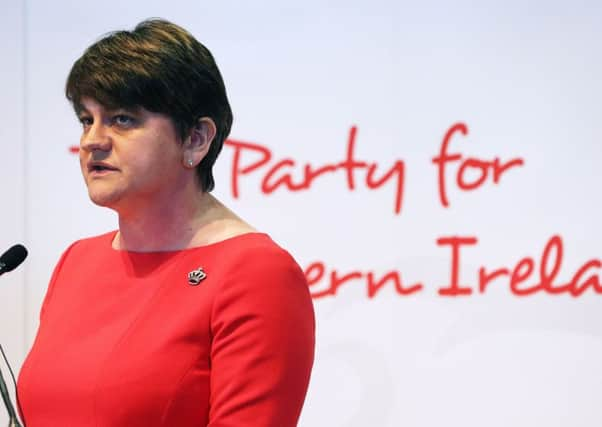Alex Kane: A boost in the unionist vote is the essential and peaceful reply to SF's unity bid


“It is quite possible that Sinn Fein could win the most seats on March 2; and it is also quite possible that unionists, for the first time ever, would not represent a majority in a Northern Ireland Parliament or Assembly.
“If it does lose that majority the political dynamics here will change and change dramatically.
Advertisement
Hide AdAdvertisement
Hide AdMore crucially, though, and putting it bluntly: if unionists can no longer deliver an overall majority in a Northern Ireland Assembly (and we’re just four years away from NI’s centenary), then they have big, big problems, further down the line.”


I actually erred on the side of optimism in that piece (something I rarely do) and concluded; “My gut instinct is that unionism will, just about, squeeze a majority – but it can’t be taken for granted.”
I was wrong: and the final result sent shockwaves through unionism.
They now (DUP, UUP, Jim Allister, Claire Sugden) account for just 40 of the 90 Assembly seats, one more than the SF/SDLP 39. Sinn Fein also came within 1,169 votes of overtaking the DUP as the largest party.
Advertisement
Hide AdAdvertisement
Hide AdIt’s no wonder that Gerry Adams has been cock-a-hoop since and pushing for a border poll as soon as possible.


On May 30, he was also joined by Colum Eastwood; who now says he wants one after the Brexit negotiations have been completed.
All elections here boil down to unionism versus nationalism and the margins between them. And in the aftermath of March 2 those margins will be pored over in even greater detail than usual.
In 2015 unionists won 11 of the 18 seats with 348,137 votes, while the SDLP/SF took 7 with 276,041.
Advertisement
Hide AdAdvertisement
Hide AdA comfortable enough gap you might think. But when you add the ‘middle-ground’ 79,753 to the tally (in which I’m including Alliance, Greens, People Before Profit the Workers Party and CISTA), then the gap between unionist and non-unionist shifts away from unionism by 355,794 to 348,137.
Of course, I’m not suggesting that the bulk of those 79,753 are anti-Union. But look at the gap between the DUP’s 184,260 (25.7%) and Sinn Fein’s 176,232 (24.5%).
In March, Sinn Fein added 48,000 votes to that total and they seem confident that they can add another few per cent.
They know that they can’t overtake unionists in seat numbers – even if they win back Fermanagh/South Tyrone and take all 3 SDLP seats, the maximum they can win is eight – but they also know the further psychological damage they would do to unionism if they nosed ahead of the DUP; or, as they did in March, run them very, very close in votes and seats.
Advertisement
Hide AdAdvertisement
Hide AdClose enough, in other words, to make another Assembly election an attractive option.
Has unionism done enough to minimise the challenge from Sinn Fein?
Well, so far, Arlene Foster hasn’t repeated the ‘crocodile’ gaffe. Sinn Fein tried to get her ‘blonde’ comments about Michelle O’Neill into play, but even their own grassroots didn’t seem all that interested.
She has also avoided what I described during the Assembly election as, the ‘monumental stupidity of putting Gerry Adams front and centre of her election campaign.’
Advertisement
Hide AdAdvertisement
Hide AdAlso – and again, I enter the ‘so far’ caveat – with the exception of Jim Wells’s comments about Sinn Fein in Rathfriland, the DUP’s ‘usual suspects’ haven’t said anything which could be described as outrageously offensive: the sort of thing that would galvanize those crucial votes that SF need if they’re to eclipse the DUP.
The only way there will be a united Ireland is if a border poll in Northern Ireland delivers a majority to leave the United Kingdom.
The only way there will be a border poll is if the Secretary of State calls one; “…if at any time it appears likely to him that a majority of those voting would express a wish that Northern Ireland should cease to be part of the United Kingdom and form part of a united Ireland.”
And the only time that it would ever appear likely is if the electoral numbers at Assembly, Westminster and local council level stack up against unionists.
Advertisement
Hide AdAdvertisement
Hide AdThat’s why numbers matter to Sinn Fein, in a way that they have never really mattered before.
There is now no other road to Irish unity for them. They could become the largest party here and they could find themselves in a coalition government in the Dáil; but none of that will make a button of difference to their unity project, because they will still need to stack up those electoral chips on their side of the table in Northern Ireland.
They still need to persuade tens of thousands of soft unionists and nationalists to come on board; and part of that persuasion depends on building up the impression that a pro-unity majority is inevitable.
Hence the non-stop campaign with electoral registration, an ever-widening socio/economic/cultural/rights agenda and unity conferences.
Put bluntly, they need the numbers to get the border poll.
Brexit helped.
Martin McGuinness’s resignation letter helped.
Foster’s ‘crocodile’ helped.
Unionists losing their Assembly majority helped.
Advertisement
Hide AdAdvertisement
Hide AdThey’re clearly hoping that a Conservative government with a strong majority and a ‘hard Brexit’ strategy will help.
But they’re still – even when you add on the SDLP vote – well short of the figure at which it would ‘appear likely’ that there was an anti-UK majority.
Which is why Sinn Fein now regards every election, at every level, as a headcount election for a border poll.
That’s understandable: they have no other credible option.
Unionism was shocked on March 2: the sort of shock you don’t want in the run-up to Northern Ireland’s centenary.
Advertisement
Hide AdAdvertisement
Hide AdSo the response to that shock is to send the very clear electoral message that, when it comes to pro and anti numbers on the Union, unionists remain, comfortably so, the majority.
After 10pm on June 8, Sinn Fein will be counting their vote and the SDLP’s vote – as well as calculating the possible unity numbers in the middle-ground tally – and measuring it against what’s required for a border poll.
They will also be counting the unionist vote.
That’s understandable.
So Sinn Fein will also understand it if unionists – who might not always be happy with some manifestations of party political unionism here – decide to come out in increased numbers and vote for DUP and UUP (and Lady Hermon) candidates next Thursday.
An increased gap between the unionist tally and the nationalist tally would be a major setback for Sinn Fein.
That’s why it is the peaceful, coherent, democratic and essential response to Sinn Fein’s unity campaign.